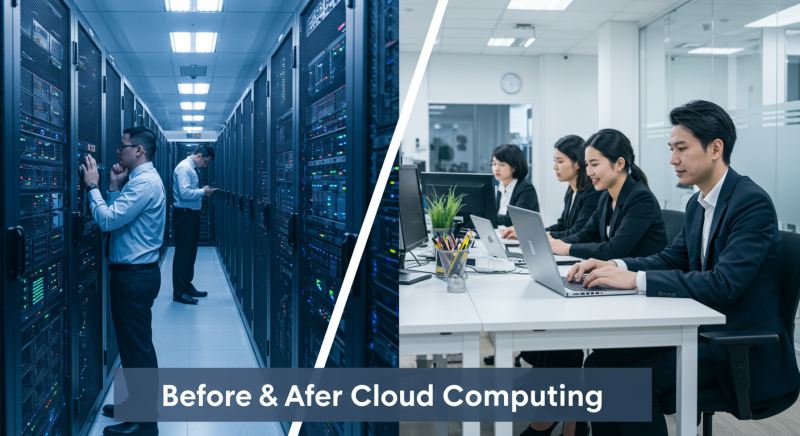In today’s hypercompetitive business landscape, cloud computing isn’t just another tech buzzword—it’s the backbone of modern American enterprise. From startups operating out of Brooklyn coffee shops to Fortune 500 giants commanding Manhattan skyscrapers, cloud computing has fundamentally altered how US companies operate, innovate, and grow. The shift to cloud computing represents perhaps the most significant technological revolution since the internet itself. In 2025, we’re witnessing American businesses not just adopting cloud computing—they’re being completely transformed by it.
Key Takeaways:
- Cloud computing reduces IT infrastructure costs by an average of 30% for US businesses
- 87% of US enterprises now have multi-cloud strategies in place
- Security concerns remain the #1 barrier to cloud computing adoption
- By 2026, over 95% of new digital workloads will be deployed on cloud-native platforms
- Small businesses adopting cloud computing report 21% faster growth rates than non-adopters

What Exactly Is Cloud Computing and Why Should US Businesses Care?
At its core, cloud computing delivers computing services—from servers and storage to databases and analytics—over the internet (“the cloud”) instead of having companies maintain their own physical infrastructure. This means US businesses can access powerful computing resources on-demand, paying only for what they use. Think of cloud computing as similar to your electricity service. You don’t generate your own power; you connect to a grid and pay for what you consume.
Similarly, with cloud computing, businesses tap into vast computational resources maintained by providers like Amazon Web Services, Microsoft Azure, and Google Cloud. According to recent data from McKinsey, US companies implementing comprehensive cloud computing strategies are seeing operating margins improve 5-10% faster than industry peers. That’s no small potatoes in today’s economic environment.
The Three Flavors of Cloud Computing That US Businesses Are Devouring
Not all cloud computing solutions are created equal. US businesses typically choose from three primary service models:
1. Infrastructure as a Service (IaaS)
IaaS provides virtualized computing resources over the internet. US businesses use IaaS to rent servers, storage, and networking components without having to purchase and maintain physical hardware. Example: A growing e-commerce company in Chicago avoided $350,000 in upfront hardware costs by moving to an IaaS cloud computing platform, scaling resources during holiday shopping peaks and reducing them during slower periods.
2. Platform as a Service (PaaS)
PaaS delivers hardware and software tools over the internet, typically for application development. American developers love PaaS because it eliminates the complexity of building and maintaining infrastructure while they create applications. Example: A healthcare startup in Boston used PaaS cloud computing to develop a patient monitoring application in just 3 months—a process that would have taken over a year using traditional development approaches.
3. Software as a Service (SaaS)
SaaS provides complete applications over the internet, eliminating installation and maintenance headaches. Think Salesforce, Microsoft 365, or Google Workspace. Example: A network of dental offices across Texas implemented SaaS cloud computing solutions, reducing IT staff requirements by 40% while improving patient scheduling efficiency by 25%.
How US Businesses Are Actually Implementing Cloud Computing (Without Losing Their Minds)
Moving to the cloud isn’t as simple as flipping a switch—something many US businesses learn the hard way. Successful cloud computing implementations typically follow these steps:
1. Assessment and Strategy
Smart US businesses start by identifying which applications and processes are cloud-compatible. Not everything belongs in the cloud, and some legacy systems may need significant reworking. A thorough cloud computing assessment should examine technical feasibility, potential cost savings, security implications, and compliance requirements. According to Deloitte, companies that develop comprehensive migration strategies achieve 30% faster implementation times.
2. Choosing the Right Cloud Model
US businesses need to determine whether public, private, hybrid, or multi-cloud architectures best serve their needs:
- Public cloud: Shared resources, highest cost savings but less control
- Private cloud: Dedicated resources, more security and control but higher costs
- Hybrid cloud: Combination of public and private, balancing cost and control
- Multi-cloud: Services from multiple providers, avoiding vendor lock-in Many US healthcare organizations, for example, use hybrid cloud computing models to keep sensitive patient data on private clouds while running less sensitive applications on public infrastructure.
3. Selecting Cloud Providers
The “Big Three” (AWS, Microsoft Azure, and Google Cloud) dominate the US cloud computing market, but specialized providers often better serve specific needs. US businesses should evaluate providers based on:
- Service reliability and performance
- Security capabilities
- Compliance certifications
- Geographic data center locations
- Cost structures
- Support quality
4. Migration and Implementation
According to IBM research, 60% of US businesses find the actual migration to cloud computing more complex than anticipated. Successful migrations typically use phased approaches:
- Start with non-critical applications
- Implement robust testing processes
- Train staff thoroughly
- Establish clear rollback procedures A mid-sized manufacturing company in Ohio successfully migrated to cloud computing by moving one department at a time over 18 months, ensuring business continuity and allowing for process optimization at each stage.
The Dollars and Sense: How Cloud Computing Affects US Business Finances
The financial impact of cloud computing extends far beyond simple cost savings. US businesses are discovering multiple financial benefits:
Capital Expenditure to Operating Expenditure
Cloud computing transforms large, unpredictable capital expenditures into predictable operational costs. This shift improves cash flow management and reduces financial risk.
Scalability Economics
US businesses using cloud computing can instantly scale resources up or down based on demand. A retail website can automatically add server capacity during sales events, then reduce resources when traffic normalizes. According to Flexera’s 2024 State of the Cloud Report, 82% of US businesses cite cost savings from improved resource scaling as a primary cloud computing benefit.
Hidden Financial Benefits
The financial advantages of cloud computing often extend beyond the obvious:
- Reduced IT staffing costs (average 15-25% reduction)
- Lower energy consumption (typically 30-40% less than on-premises)
- Decreased software licensing expenses
- Business continuity without redundant systems
- Faster time-to-market for new initiatives
“But Is It Safe?” Security Considerations in Cloud Computing
Security remains the top concern for US businesses considering cloud computing. A 2024 survey by the Cloud Security Alliance found that 73% of US companies cite security as their primary cloud computing worry. The truth? Cloud computing can be more secure than on-premises solutions—but only with proper implementation:
Shared Responsibility Model
In cloud computing, security responsibility is shared between provider and customer. Providers secure the infrastructure, but businesses remain responsible for data security, access management, and compliance.
Essential Security Measures
US businesses implementing cloud computing should prioritize:
- Strong authentication: Implement multi-factor authentication for all cloud access
- Data encryption: Encrypt sensitive data both in transit and at rest
- Access controls: Follow principle of least privilege
- Security monitoring: Implement 24/7 monitoring of cloud environments
- Regular audits: Conduct regular security assessments A regional bank in Michigan prevented a potentially devastating data breach by implementing comprehensive cloud computing security measures that detected unusual access patterns before sensitive customer data could be compromised.

The Cloud Computing Future That US Businesses Should Prepare For
As cloud computing continues evolving, US businesses should keep an eye on these emerging trends:
Edge Computing Integration
The integration of edge computing with traditional cloud computing is accelerating. This hybrid approach processes data closer to where it’s created before sending relevant information to the cloud. According to Gartner, by 2026, over 50% of US enterprises will use distributed cloud options that process data at the point of creation.
AI and Machine Learning Democratization
Cloud computing is making advanced AI capabilities accessible to businesses of all sizes. US companies without data science teams can now leverage sophisticated machine learning through cloud-based AI platforms. A small agricultural business in Iowa used cloud computing AI services to analyze crop data and optimize irrigation, increasing yields by 14% without hiring specialized staff.
Serverless Computing Expansion
Serverless cloud computing abstracts infrastructure management even further, allowing US developers to focus purely on code while the cloud provider handles all server management automatically.
Industry-Specific Cloud Solutions
Vertical cloud computing solutions tailored to specific industries are growing rapidly. Healthcare, financial services, manufacturing, and retail all benefit from specialized cloud platforms built for their unique requirements.
When Cloud Computing Goes Wrong: Lessons from US Business Fails
Not every cloud computing implementation succeeds. Learning from others’ mistakes can help US businesses avoid costly errors:
The “Lift and Shift” Trap
Simply moving existing applications to the cloud without redesigning them for cloud computing environments often results in higher costs and worse performance. A large retail chain learned this lesson after migrating their inventory management system “as is” to the cloud, only to discover it performed poorly and cost 40% more than anticipated. The solution? Redesigning the application to be cloud-native.
Underestimating Network Demands
Many US businesses discover that cloud computing significantly increases their bandwidth requirements, leading to network bottlenecks and performance issues.
Cost Management Failures
Without proper monitoring and governance, cloud computing costs can spiral out of control. A tech startup in California received a shocking $30,000 cloud bill after developers accidentally left test environments running for months.
Cloud Computing Success Stories: US Businesses That Got It Right
Manufacturing Sector Transformation
A medium-sized manufacturing company in Michigan embraced cloud computing to connect their factory floor. By implementing IoT sensors connected to cloud analytics platforms, they reduced equipment downtime by 37% and cut maintenance costs by $450,000 annually.
Healthcare Innovation
A hospital network in California used cloud computing to create a unified patient record system across 12 facilities. The solution improved care coordination, reduced duplicate testing by 28%, and saved an estimated $3.7 million in the first year alone.
Small Business Revolution
A family-owned restaurant chain in Texas leveraged cloud computing to implement sophisticated customer analytics previously available only to major corporations. The resulting insights helped them personalize marketing efforts, increasing repeat customer visits by 22%.

Conclusion: The Cloud Computing Imperative for US Business
In 2025, cloud computing isn’t just an option for US businesses—it’s an imperative for remaining competitive. The organizations thriving today are those that view cloud computing not merely as an IT decision but as a fundamental business strategy. The most successful US companies approach cloud computing with clear objectives, thoughtful implementation strategies, and a commitment to continuous optimization. They recognize that the cloud journey doesn’t end with migration—it’s an ongoing evolution that requires regular reassessment and refinement. As cloud computing continues maturing, the gap between cloud leaders and laggards will likely widen. US businesses that leverage cloud technologies to increase agility, enhance customer experiences, and drive innovation will increasingly outperform those clinging to legacy approaches. The message is clear: The business future is in the cloud. Is your organization ready to soar?
Frequently Asked Questions
Is cloud computing more expensive than on-premises solutions?
While cloud computing appears more expensive on a pure monthly cost comparison, the total cost of ownership is typically 20-40% lower when accounting for hardware replacement, maintenance, staffing, energy costs, and the business value of improved agility.
What types of businesses benefit most from cloud computing?
While all industries can benefit from cloud computing, those experiencing variable demand (retail, entertainment), requiring high computational power (engineering, research), or with distributed workforces (professional services) often see the greatest advantages.
How long does cloud migration typically take for a mid-sized US business?
Most mid-sized US businesses complete initial cloud computing migrations within 6-18 months, depending on complexity. However, optimization and modernization continue indefinitely as organizations mature their cloud capabilities.
What certifications should US businesses look for in cloud providers?
Important certifications include SOC 2, ISO 27001, PCI DSS, HIPAA compliance (for healthcare), and FedRAMP (for government contractors). The specific certifications needed depend on your industry’s regulatory requirements.
How can US businesses address the cloud skills gap in their organizations?
Successful approaches include training existing IT staff, partnering with cloud computing managed service providers, hiring cloud specialists, and implementing formal cloud centers of excellence within the organization.
READ MORE
Discover the Shocking Facts About Scholarships Today
